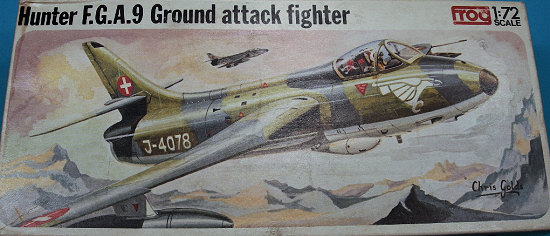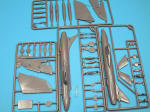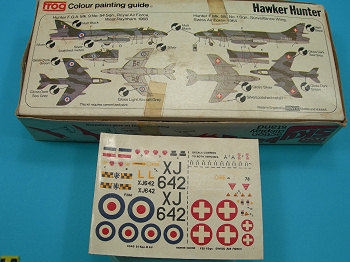
| KIT: | Frog 1/72 Hunter FGA.9 |
| KIT #: | F 204 |
| PRICE: | $ |
| DECALS: | Two options |
| REVIEWER: | Vic Scheuerman |
| NOTES: | Released in 1974 |

| HISTORY |
Hunters provided the mainstay of R.A.F. Fighter Command from 1954-1959 following the long era of the Meteors. The FGA 9 version was based on the earlier F 6 but was tropicalised and equipped with a tail parachute, extra wing fittings for the ground-attack weapons and drop tanks. FGA 9s were widely used in the Middle and Far East and No. 20 Squadron, based in Malaysia was only disbanded in 1970 (thanks to the kit history sheet).
Not only was the Hunter widely used by the RAF and RN in a variety of roles, it was also a big export success at the time. Both the Netherlands and Belgium produced it under license. Exports (including refurbished aircraft) were; Sweden, Denmark, Peru, India, Switzerland, United Emirate Air Force, Chile, Iraq, Kenya, Kuwait, Lebanon, The Sultan of Oman, Jordan, Qatar, Rhodesia and Singapore.
With this many operators on a variety of continents, the selection for external finishes is great.
| THE KIT |
 This
is one of the later aircraft from the FROG line. As such, it is very cleanly
molded and features petit raised panel lines combined with engraved control
hinge lines. A plus is that the ailerons, landing flaps and rudder are molded to
one side which makes these trailing edges thin. This kit cockpit as was common
on all the FROG kits that I have experience with is ‘modest’ when it comes to
supplied detail. No fuselage wall detail and an ejection seat ‘shape’ attaches
to a partial floor. Somewhat different, perhaps unique, there is a ‘keel
bulkhead’ supplied for the interior fuselage aft of the seat to supply some
rigidly?
This
is one of the later aircraft from the FROG line. As such, it is very cleanly
molded and features petit raised panel lines combined with engraved control
hinge lines. A plus is that the ailerons, landing flaps and rudder are molded to
one side which makes these trailing edges thin. This kit cockpit as was common
on all the FROG kits that I have experience with is ‘modest’ when it comes to
supplied detail. No fuselage wall detail and an ejection seat ‘shape’ attaches
to a partial floor. Somewhat different, perhaps unique, there is a ‘keel
bulkhead’ supplied for the interior fuselage aft of the seat to supply some
rigidly?
FROG offers two sets of
undercarriage doors so the modeller has the option of posing the Hunter in
flight (pilot supplied) or static. The doors themselves capture the shapes well
enough, but would look better if sanded thinner. Main gear legs are nicely done
while the nose gear and tire are one piece. One of the negatives in this kit for
me was that none of the wheel wells are framed in and the nose bay has no roof.

As the Hunter FGA 9 (Fighter Ground Attack) was meant for air support, the wing options include a Matra rocket pod in addition to the wing tanks and these attached to separate pylons and look good.
FROG supplied assembly instructions that were well-drawn and easy to follow. However, no interior colour notes were offered. FROG included the best decals in the industry at the time and those in the kit still look good and useable. The first option is a RAF Hunter of 54 Squadron, circa 1968 and it is camouflaged in Dark Green and Dark Sea Grey uppers over Light Aircraft Grey. This jet has the high-viz D roundels with 54 Squadrons yellow and blue checked squadron insignia tastefully carried on the nose. A Hunter F Mk. 58 of the Swiss No. 1 Surveillance Wing is the second option. It has the same upper colours but with the earlier painted silver bottoms. No. I Wing stylizes white eagle is carried on the nose and is a rather attractive motif. In addition to the great kit decals, FROG offered the decal options in full colour on the back of the box (or header card).
| CONCLUSIONS |
The modest cockpit really is not that big of a drawback as the Brits wisely painted their cockpits black for some time. If you can live with unframed wells, then this 30 year old kit would look good by simply sanding the gear doors thinner or better yet posed in flight. It could be a great nostalgic trip, especially using the original decals. While the second Airfix and current Revell Hunters are better and much better, do not dismiss this kit out of hand.
| REFERENCES |
The Complete Book of Fighters, W Green & G Swanborough, Salamander
The Encyclopedia of World Air Power, B Gunston, Hamyln Aerospace
May 2007
If you would like your product reviewed fairly and quickly by a site that has over 350,000 visitors a month, please contact me or see other details in the Note to Contributors.